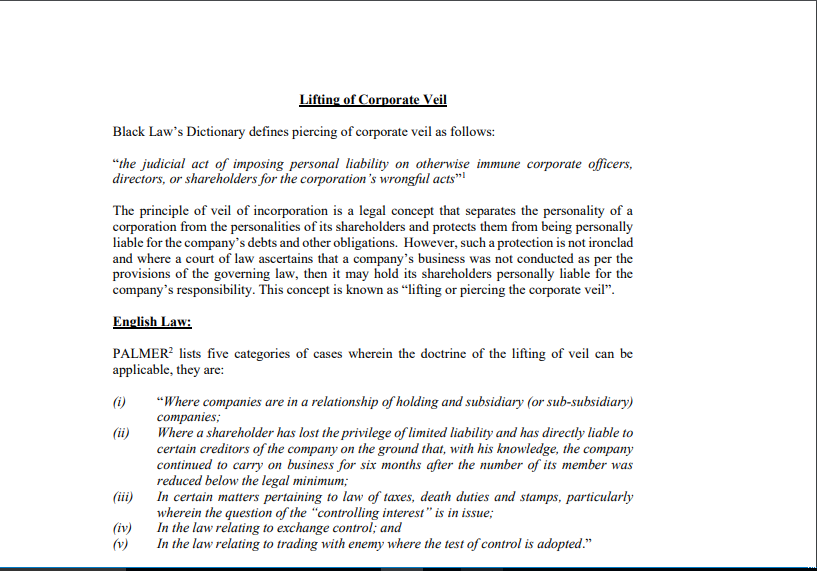Brief Note on Lifting the Corporate Veil
Lifting of Corporate Veil
Black Law’s Dictionary defines piercing of corporate veil as follows:
“the judicial act of imposing personal liability on otherwise immune corporate officers, directors, or shareholders for the corporation’s wrongful acts”
The principle of the veil of incorporation is a legal concept that separates the personality of a corporation from the personalities of its shareholders and protects them from being personally liable for the company’s debts and other obligations. However, such protection is not ironclad and where a court of law ascertains that a company’s business was not conducted as per the provisions of the governing law, then it may hold its shareholders personally liable for the company’s responsibility. This concept is known as “lifting or piercing the corporate veil”.
English Law:
PALMER lists five categories of cases wherein the doctrine of the lifting of the veil can be applicable, they are:
(i) “Where companies are in a relationship of holding and subsidiary (or sub-subsidiary) companies;
(ii) Where a shareholder has lost the privilege of limited liability and has directly liable to certain creditors of the company on the ground that, with his knowledge, the company continued to carry on business for six months after the number of its member was reduced below the legal minimum;
(iii) In certain matters pertaining to law of taxes, death duties and stamps, particularly wherein the question of the “controlling interest” is in issue;
(iv) In the law relating to exchange control; and
(v) In the law relating to trading with enemy where the test of control is adopted.”
In the leading case of Lee v. Lee’s Air Farming Ltd. It was held by Privy Council that Lee is a separate entity from the company which was controlled by Lee, who would be an employee of the company, so the wife of Lee can claim compensation for his death under the workmen’s compensation act.
Another famous case wherein the court had lifted the corporate veil was in Daimler Co. Ltd. v. Continental Tyre and Rubber Co.- this is an instance of determination of the enemy character of a company and the court held that if the persons or agents having de facto control are residents in an enemy country, or wherever resident is adhering to the enemy or taking instructions from the enemy.
Indian Law:
In Life Insurance Corporation of India v. Escorts Limited and Others, the Supreme Court laid down two major cases wherein the corporate veil may be lifted. These are –
(i) Judicial Grounds:
The courts in India can lift the corporate veil on certain grounds on the following grounds:
(a) Fraud Improper Conduct:
One of the most common grounds for the lifting of corporate veils, in cases wherein the shareholders of the company are indulging in fraudulent acts. In the case of Shri Ambica Mills Ltd., Re, it was held that the corporate veil of the company can be lifted in cases of criminal acts of fraud by officers of a company. Similarly, in the English case of VTB Capital v. Nutritek, the court had held the directors personally liable for obtaining a loan fraudulently. Furthermore, in the case of Delhi Development Authority v. Skipper Construction Company it was held by the court that “where, therefore, the corporate character is employed for the purpose of committing illegality or for defrauding others, the court would ignore the corporate character and will look at the reality behind the corporate veil so as to enable it to pass appropriate orders to do justice between the parties concerned”.
(b) Tax Evasion:
The corporate veil may be lifted for the purpose of preventing tax evasion. In the Vodafone case, the court had observed that “once the transaction is shown to be fraudulent, sham, circuitous or a device designed to defeat the interests of the shareholders, investors, parties to the contract and also for tax evasion, the Court can always lift the corporate veil and examine the substance of the transaction”.
(c) The company as an Agent:
The principle of vicarious liability is applicable in cases where the agent is acting for the shareholders. The courts will determine the liability of the shareholders based on the fact of whether the agent was acting as an agent for the shareholders or not. Thus, it is necessary to identify the principal and agent concerning an illegal act performed by the agent, then the corporate veil will be lifted.
(ii) Statutory Provisions:
(a) Officer in Default (Section 2 (60) of the Companies Act, 2013 (“Act”)):
This section deals with the liability of an officer in default, i.e., those individuals who are involved in illegal or wrongful activities and are thus liable for the offences personally. Furthermore, this section also deals with the joint or several liabilities of the members of a company.
(b) Fraudulent conduct (Section 339 of the Act):
wherever in case of winding up of the company, it is found that company’s name was being used for carrying out fraudulent activity, the courts have the power to hold any person personally liable for such an activity. Delhi Development Authority v. Skipper Construction Company10, the court held that “where, therefore, the corporate character is employed for the purpose of committing illegality or for defrauding others, the court would ignore the corporate character and will look at the reality behind the corporate veil so as to enable it to pass appropriate orders to do justice between the parties concerned”.
Conclusion:
As a result of incorporation, an incorporated company wears a “corporate veil” and thus acquires the ‘corporate personality’, behind which there are shareholders/members who have formed the company. Although in law the company has an independent personality, it is an artificial person and hence, behind the corporate curtain, there are natural persons, i.e. shareholders. This corporate personality may be unveiled in certain situations where it is used for illegal or fraudulent activities, and the shareholders or the directors behind it may be held responsible. However, even though the legislature and the courts have in many cases now allowed the corporate veil to be lifted, it should be noted that the principle of veil of incorporation, that is separate legal existence of a company, is still the rule and the instances of lifting or piercing the veil are the exceptions to this rule.
Download the copy:
If you already have a premium membership, Sign In.














